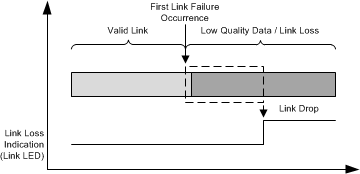SNLS656D August 2020 – December 2023 DP83TD510E
PRODUCTION DATA
- 1
- 1 Features
- 2 Applications
- 3 Description
- 4 Pin Configuration and Functions
- 5 Specifications
-
6 Detailed Description
- 6.1 Overview
- 6.2 Functional Block Diagram
- 6.3
Feature Description
- 6.3.1 Auto-Negotiation (Speed Selection)
- 6.3.2 Repeater Mode
- 6.3.3 Media Converter
- 6.3.4 Clock Output
- 6.3.5 Media Independent Interface (MII)
- 6.3.6 Reduced Media Independent Interface (RMII)
- 6.3.7 RMII Low Power 5-MHz Mode
- 6.3.8 RGMII Interface
- 6.3.9 Serial Management Interface
- 6.3.10 Extended Register Space Access
- 6.3.11 Loopback Modes
- 6.3.12 BIST Configurations
- 6.3.13 Cable Diagnostics
- 6.4 Device Functional Modes
- 6.5 Programming
- 6.6 MMD Register Address Map
- 6.7 DP83TD510E Registers
- 7 Application and Implementation
- 8 Device and Documentation Support
- 9 Revision History
- 10Mechanical, Packaging, and Orderable Information
Package Options
Mechanical Data (Package|Pins)
- RHB|32
Thermal pad, mechanical data (Package|Pins)
- RHB|32
Orderable Information
6.3.13.2 Fast Link Down Functionality
The DP83TD510E includes advanced link-down capabilities that support various real-time applications. The link-down mechanism is configurable and includes enhanced modes that allow extremely fast link-drop reaction times.
The DP83TD510E supports an enhanced link drop mechanism, also called Fast Link Drop (FLD), which shortens the observation window for determining link. There are multiple ways of determining link status, which can be enabled or disabled based on user preference. Fast Link Drop can be enabled in software using register configuration. FLD can be configured using the Control Register #3 (CR3, address 0x000B). Bits[3:0] and bit[10] allow for various FLD conditions to be enabled. When link drop occurs, indication of a particular fault condition can be read from the Fast Link Down Status Register (FLDS, address 0x000F).
 Figure 6-9 Fast Link Down
Figure 6-9 Fast Link DownFast Link Down criteria include:
- RX Error Count - when a predefined number of 32 RX_ERs occur in a 10μs window, the link will be dropped.
- MLT3 Error Count - when a predefined number of 20 MLT3 errors occur in a 10μs window, the link will be dropped.
- Low SNR Threshold - when a predefined number of 20 threshold crossings occur in a 10μs window, the link will be dropped.
- Signal/Energy Loss - when the energy detector indicates energy loss, the link will be dropped.
The Fast Link Down functionality allows the use of each of these options separately or in any combination.
Because this mode enables extremely quick reaction time, it is more exposed to temporary bad link-quality scenarios.